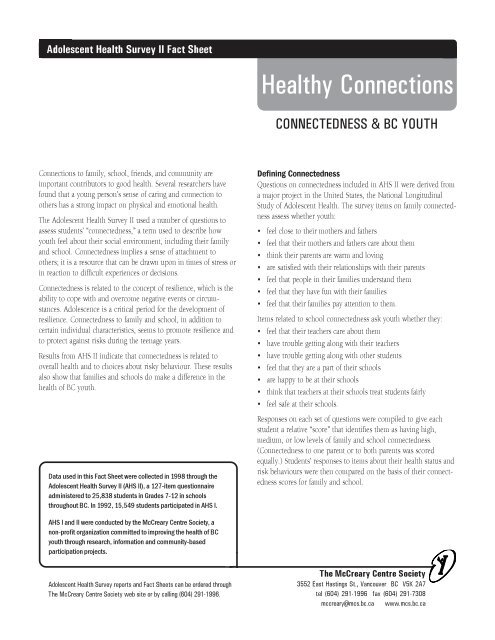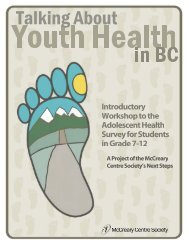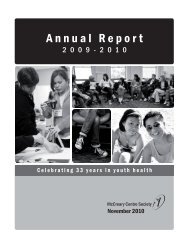Healthy Connections: Connectedness and BC Youth - McCreary ...
Healthy Connections: Connectedness and BC Youth - McCreary ...
Healthy Connections: Connectedness and BC Youth - McCreary ...
You also want an ePaper? Increase the reach of your titles
YUMPU automatically turns print PDFs into web optimized ePapers that Google loves.
Adolescent Health Survey II Fact Sheet<strong>Healthy</strong> <strong>Connections</strong>CONNECTEDNESS & <strong>BC</strong> YOUTH<strong>Connections</strong> to family, school, friends, <strong>and</strong> community areimportant contributors to good health. Several researchers havefound that a young person’s sense of caring <strong>and</strong> connection toothers has a strong impact on physical <strong>and</strong> emotional health.The Adolescent Health Survey II used a number of questions toassess students’ “connectedness,” a term used to describe howyouth feel about their social environment, including their family<strong>and</strong> school. <strong>Connectedness</strong> implies a sense of attachment toothers; it is a resource that can be drawn upon in times of stress orin reaction to difficult experiences or decisions.<strong>Connectedness</strong> is related to the concept of resilience, which is theability to cope with <strong>and</strong> overcome negative events or circumstances.Adolescence is a critical period for the development ofresilience. <strong>Connectedness</strong> to family <strong>and</strong> school, in addition tocertain individual characteristics, seems to promote resilience <strong>and</strong>to protect against risks during the teenage years.Results from AHS II indicate that connectedness is related tooverall health <strong>and</strong> to choices about risky behaviour. These resultsalso show that families <strong>and</strong> schools do make a difference in thehealth of <strong>BC</strong> youth.Data used in this Fact Sheet were collected in 1998 through theAdolescent Health Survey II (AHS II), a 127-item questionnaireadministered to 25,838 students in Grades 7-12 in schoolsthroughout <strong>BC</strong>. In 1992, 15,549 students participated in AHS I.Defining <strong>Connectedness</strong>Questions on connectedness included in AHS II were derived froma major project in the United States, the National LongitudinalStudy of Adolescent Health. The survey items on family connectednessassess whether youth:• feel close to their mothers <strong>and</strong> fathers• feel that their mothers <strong>and</strong> fathers care about them• think their parents are warm <strong>and</strong> loving• are satisfied with their relationships with their parents• feel that people in their families underst<strong>and</strong> them• feel that they have fun with their families• feel that their families pay attention to them.Items related to school connectedness ask youth whether they:• feel that their teachers care about them• have trouble getting along with their teachers• have trouble getting along with other students• feel that they are a part of their schools• are happy to be at their schools• think that teachers at their schools treat students fairly• feel safe at their schools.Responses on each set of questions were compiled to give eachstudent a relative “score” that identifies them as having high,medium, or low levels of family <strong>and</strong> school connectedness.(<strong>Connectedness</strong> to one parent or to both parents was scoredequally.) Students’ responses to items about their health status <strong>and</strong>risk behaviours were then compared on the basis of their connectednessscores for family <strong>and</strong> school.AHS I <strong>and</strong> II were conducted by the <strong>McCreary</strong> Centre Society, anon-profit organization committed to improving the health of <strong>BC</strong>youth through research, information <strong>and</strong> community-basedparticipation projects.Adolescent Health Survey reports <strong>and</strong> Fact Sheets can be ordered throughThe <strong>McCreary</strong> Centre Society web site or by calling (604) 291-1996.The <strong>McCreary</strong> Centre Society3552 East Hastings St., Vancouver <strong>BC</strong> V5K 2A7tel (604) 291-1996 fax (604) 291-7308mccreary@mcs.bc.ca www.mcs.bc.ca
<strong>Connectedness</strong> <strong>and</strong> ResilienceResilience enables individuals to cope with problems resultingfrom life circumstances— including abuse, illness, family conflictor poverty— or as a result of experimenting with risky behaviours.Once exposed to such stresses, some youth appear to be at higherrisk for further negative outcomes, while others manage tofunction well despite these challenges.Percentage of <strong>Youth</strong> With Emotional DistressSexual Abuse No Sexual Abuse50%35AHS II results show that adolescents who have been bullied,abused, or who have a chronic illness or disability are at greaterrisk for negative health status <strong>and</strong> risky behaviour. However, thisrisk is reduced for those youth with higher levels of connectedness.Percentage of <strong>Youth</strong> Who Report Physical Assaults25%0%15 15Low familyconnectedness4Medium-high familyconnectedness50%25%0%Chronic Illness/Disability3722Percentage of <strong>Youth</strong> Who Attempted Suicide50%Low familyconnectednessBullied2314Medium familyconnectednessNot BulliedNo Chronic Illness/Disability149High familyconnectednessFor example, although sexually abused youth are generally morelikely to be emotionally distressed than non-abused youth (20%vs. 6%), those sexually abused youth who are more highlyconnected to their families are at lower risk for experiencingemotional distress (see figure). Thirty-five percent of sexuallyabused youth who have low family connectedness report beingemotionally distressed, compared to 15% of sexually abused youthwho have medium-high family connectedness. Similarly, youthwho have a chronic illness or disability have a higher likelihood ofbeing physically assaulted (25% vs. 15%). However, the differencebetween physical assaults in youth with a chronic illness/disabilityas compared to those without, is smaller in highly connectedyouth. The AHS also shows that youth who are bullied at schoolare more likely to attempt suicide (11% vs. 4%). The proportion ofyouth who have been bullied who have also attempted suicide, islower for youth who are more highly connected to school. These<strong>and</strong> other findings from the AHS results suggest that high levels ofconnectedness promote resilience <strong>and</strong> enable youth to cope withchallenges <strong>and</strong> negative experiences.25%1913960%Low schoolconnectedness4Medium schoolconnectedness2High schoolconnectednessThe <strong>McCreary</strong> Centre Society3552 East Hastings St.Vancouver, <strong>BC</strong> V5K 2A7tel (604) 291-1996fax (604) 291-7308mccreary@mcs.bc.cawww.mcs.bc.ca4 The <strong>McCreary</strong> Centre Society






